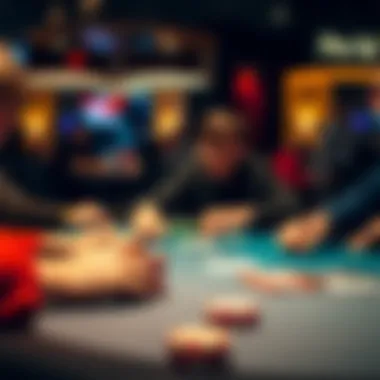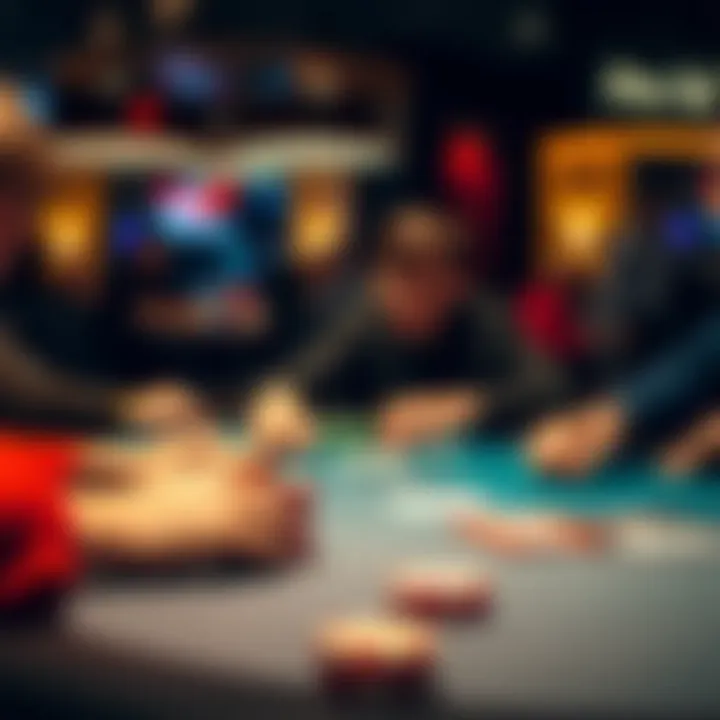Mastering PLO Tournament Strategy: Essential Insights


Intro
In the realm of poker, especially within Pot-Limit Omaha (PLO), the path to tournament success is intricately woven with strategy, psychology, and a keen understanding of the game dynamics. Unlike its cousin Texas Hold'em, PLO involves a unique approach to hand valuation, pot management, and betting decisions. As players sit down at the table, their decisions must operate on multiple levels, encompassing tactics, position play, and risk assessment. This guide aims to unravel these complexities, offering an in-depth analysis of techniques and approaches that can elevate your tournament play.
As the popularity of PLO continues to ascend, with numerous players trying their hand at the game, understanding the fundamental and advanced strategies becomes crucial. This article does not merely scratch the surface; it digs deep into what truly makes PLO an engaging yet challenging format. Whether you're a newcomer eager to learn the ropes or an experienced player looking to refine your methods, the insights offered here will help shape your journey to success. It's time to roll up your sleeves and delve into the intricate world of PLO tournament strategy.
Game Strategies
To begin with, mastering game strategies is essential for anyone who wishes to step up their PLO game. Novices often find themselves grappling with the intricacies of hand selection and betting. To turn the tide in your favor, it's crucial to build a solid foundation of poker strategies.
Essential Poker Strategies for Beginners
- Hand Selection: Begin with solid hand selection. Unlike Texas Hold'em, where pocket pairs can reign supreme, PLO rewards connected and suited hands. Look for hands like A♠K♠J♦10♦; such combinations offer both straight and flush possibilities.
- Positional Awareness: Position is a powerful tool in poker. Playing from an early position often requires stronger hands, while later positions allow you to play a wider range of hands and make more informed decisions based on opponents’ actions.
- Reading Opponents: Pay attention to betting patterns. Is someone overly aggressive or does a player fold at the first sign of pressure? Understanding opponents' tendencies can give you an edge.
Advanced Betting Techniques to Maximize Winnings
Moving beyond basics, honing advanced betting techniques can significantly impact your tournament success. Here’s how you can fine-tune your approach:
- Pot Control: Knowing when to build a pot and when to keep the pot smaller is vital. It’s often best to keep pots manageable unless you’re confident you have the best hand.
- C-betting Strategy: The continuation bet can be a powerful weapon. If you raised pre-flop and the flop isn’t favorable for you, consider checking to induce bets or to gather information about your opponents' hands.
- Exploiting Weaknesses: If you observe that a player frequently folds to aggression, ramp up your bluffing frequency against them. Conversely, if an opponent rarely gives up, it might be wise to only engage them with premium holdings.
“Great players make adjustments. The ability to evaluate both your play and your opponents’ is what sets you apart in the long run.”
By mastering these strategies, you can construct a formidable game plan. PLO requires not only technical skill but also the ability to adapt to a fast-evolving playing environment. With a blend of solid foundational tactics and advanced strategies, you stand a better chance of outmaneuvering your opponents and seizing victory at the table.
Industry Trends
Understanding the current trends in the poker industry can also refine your PLO strategy. Namely, the rising tide of online poker platforms has reshaped how many players approach the game.
The Rise of Online Poker Platforms
As virtual tables grow in popularity, players are finding themselves encouraged to practice and refine their skills in a less intimidating environment. Online platforms allow you to experience a variety of play styles and strategies from people around the globe.
Understanding Betting Odds and Their Impact
Grasping betting odds is critical for effective decision-making in poker. Knowing the pot odds and implied odds helps in calculating whether or not to pursue a draw. In PLO, where pots can grow tremendously due to the nature of the betting structure, understanding these concepts can greatly influence the outcomes of your decisions. For a deeper dive into poker odds, check out Wikipedia for a thorough explanation.
By synthesizing these concepts into your gameplay, you’ll find that success on the PLO tournament circuit is built not just on luck, but on informed, strategic decisions. This comprehensive examination of both fundamental and advanced strategies serves as your guide to navigate the complexities of Pot-Limit Omaha tournaments efficiently.
Understanding Pot-Limit Omaha
In the world of poker, Pot-Limit Omaha (PLO) stands as a unique variant that poses both challenges and opportunities. Understanding the intricacies of PLO is fundamental for players looking to excel in tournaments. Unlike its more popular cousin, Texas Hold'em, PLO requires a deeper comprehension of hand dynamics, betting strategies, and game flow. The importance of grasping these concepts cannot be overstated, as they lay the groundwork for making informed decisions at the table.
The Basics of PLO
To appreciate PLO, one must first understand its basic mechanics. In PLO, each player receives four hole cards instead of the traditional two found in Texas Hold'em. This fundamental difference alters the way players evaluate hand strength and potential combinations. Players must use exactly two of their hole cards in conjunction with three community cards to form the best five-card hand.
Why is this crucial? With more hole cards in play, the potential for stronger hands increases, making the game inherently more complex. For instance, a simple pair in Texas Hold'em may not hold as much weight in PLO, where hands like two pairs or even straights and flushes are more common. Thus, familiarity with hand values, potential draws, and board textures becomes essential for those seeking a competitive edge.
Differences Between PLO and Texas Hold'em
Both PLO and Texas Hold'em share core principles but diverge significantly in strategy and gameplay. Here are a few fundamental differences:
- Number of Hole Cards: In Hold'em, players receive two hole cards, while PLO players contend with four. This change inherently boosts potential hand combinations.
- Betting Structure: As the name suggests, in PLO, the maximum bet a player can make is limited to the current size of the pot. This makes betting and raising more complex, requiring players to be acutely aware of pot sizes.
- Hand Evaluation: Players must adapt their hand evaluation skills. A hand that could be a winner in Hold'em might not suffice in PLO, given the higher possibility of stronger hands being present.
These differences demand not just a shift in play style but an entirely new strategy to thrive in PLO tournaments.
PLO Hand Rankings
Understanding hand rankings in PLO is crucial for success. Unlike Texas Hold'em, where a lower combination might still secure victory, PLO often rewards high-value hands more aggressively. Here’s a brief overview of hand rankings in PLO:
- Royal Flush – The highest hand, consisting of A-K-Q-J-10, all of the same suit.
- Straight Flush – Five consecutive cards of the same suit.
- Four of a Kind – Four cards of the same rank, a strong hand indeed.
- Full House – A combination of three of one rank and two of another.
- Flush – Five cards of the same suit, not in sequence.
- Straight – Five consecutive cards of any suit.
- Three of a Kind – Three cards of the same rank.
- Two Pair – Two cards of one rank and two cards of another.
- One Pair – Two cards of the same rank and three unrelated cards.
- High Card – The highest single card if no better hand is made.
In PLO, the focus should not merely be on the strength of individual hands but also on the potential for drawing to stronger hands post-flop. Utilizing this understanding of hand rankings, players can strategically navigate their betting and raises, ultimately leading to a more informed and successful approach at the table.
Initial Strategy Considerations
Understanding the landscape of a Pot-Limit Omaha tournament can be a daunting task, but laying a solid foundation through initial strategy considerations is critical to success. This section scrutinizes various elements that shape decisions at the table and provides insight on how to adapt to the contest's nuances. Key factors include understanding opponents, adjusting to different playing styles, and managing your bankroll effectively. These elements don't just set the tone for your game; they enhance your capability to navigate through the various phases of the tournament.
Understanding Your Opponents
Player Types
In Pot-Limit Omaha, recognizing different player types can make or break your tournament. Common archetypes include the aggressive player, who constantly applies pressure, and the passive player, who tends to call rather than raise. It’s crucial to identify the movers and shakers among your competitors. Reading player types often helps strategize how to exploit their tendencies. For instance, against an aggressive player, you might want to focus on trapping with strong hands, while a passive player could be a goldmine for extracting value. However, be cautious; leaning too much into preconceived notions may lead you astray, as players often adapt.


Reading Opponent Behavior
The art of reading opponent behavior ties closely to your overall strategy. Observations during gameplay, such as betting patterns, timing, and emotional tells, hold immense weight. A tremor in a hand or a quick raise can say more than the cards on the table. Being observant allows players to pinpoint possible bluffing opportunities or genuine strength. Track how opponents respond under pressure; are they composed or do they act out of character? The unique feature here is your ability to leverage psychological insights gained from your observations, which can help shape your strategy. The downside? Misreading a player's demeanor can lead to costly mistakes, so balance your intuition with factual evidence.
Adjusting to Different Styles of Play
Every player brings their unique flavor to the table. You might encounter a tight, conservative player setting the pace in early hands, while another might shoot from the hip, creating chaos by pushing the envelope. Adapting your style against these diverse tactics can keep you one step ahead. Observe their raises, calls, and when they choose to fold, using that information to tailor your approach. A flexible mindset allows for better decision-making and the ability to capitalize on the weaknesses of those around you.
Bankroll Management in Tournaments
Importance of Risk Management
Managing risk is more than just hedging against large losses; it’s about ensuring longevity in the tournament. Many players overlook this crucial aspect and pay the price later on. Implementing a sound risk management strategy can keep you in the game longer and better position you for potential winnings. Knowledge of pot odds, implied odds, and expected value can guide when to put your money at stake. The upside is greater sustainability in a tournament, but often players can feel the pinch of discipline, struggling with emotional decisions.
Setting Tournament Budgets
Setting budgets for particular tournaments establishes behavioral guidelines for managing your bankroll. This prudent practice involves evaluating your financial situation and determining how much you're willing to invest in PLO tournaments. A good budget helps balance fun and caution, preventing the lure of high-stakes play from skewing your financial health. A well-defined budget is particularly critical in multi-day events, where participants can be tempted to chase losses. Identifying a budgetary limit, while perhaps an unpopular choice for players gunning for glory, can ensure that you don't end up in the pits.
By understanding these tenets of initial strategy considerations, participants position themselves better for success. Adapting to player types, learning to read behaviors, managing risk, and budgeting effectively become the cornerstones of a formidable PLO tournament strategy.
Pre-Flop Strategy
In the realm of Pot-Limit Omaha, establishing a robust pre-flop strategy sets the tone for the entire tournament. This phase isn’t just about choosing which hands to play; it shapes how players will interact with each other, how pots will be built, and ultimately, the trajectory of one's tournament life. Having a clear pre-flop strategy helps players mitigate risks, maximize potential gains, and lays the groundwork for a strong chip stack to navigate the middle and late stages of a tournament.
Hand Selection Guidelines
Premium Hands vs. Marginal Hands
When it comes to selecting hands in PLO, distinguishing between premium and marginal hands is paramount. Premium hands typically include high pairs like Aces or Kings paired with high cards and suited connectors. In contrast, marginal hands are often those that, while they may seem decent, lack the strength and potential to carry a player through complex board scenarios.
Key Characteristics: Premium hands have higher potential to make strong combinations—for instance, doubling up or hitting a nut straight against opponents. This advantage becomes crucial in tournament settings where every chip counts.
Conversely, marginal hands, like lower suited connectors, might catch a player off guard but often lead to tough decisions later on due to their limited equity against higher-value hands. While they can sometimes provide the element of surprise, relying on them too much can turn into a slippery slope. Each hand choice should be weighed carefully against not only the potential but also the risks involved.
Advantages and Disadvantages: Premium hands tend to set themselves up for easier post-flop decision-making, while marginal hands may create complexity and indecision that can lead to significant loss of chips. The choice comes down to understanding the situations at hand and knowing when to play it safe or when to take calculated risks.
Positional Awareness in PLO
Position plays a crucial role in poker, but in PLO, it gains even greater significance due to the intricate nature of betting and hand strength dynamics. Players acting late have the benefit of observing previous moves, allowing them to make more informed decisions.
Key Characteristic: Positional awareness involves understanding how different spots around the table can influence outcomes in the game. For example, being in a late position often lets players check the waters and analyze how aggressive their opponents are being. This knowledge can help a player decide whether to play conservatively or lean into the aggression.
Advantages and Disadvantages: A strong position can significantly boost a player’s chances of making insightful calls or bets, whereas playing from an early position can limit options and open one up to more risk since the player has to act before knowing how others will respond. Optimal positioning can transform an average hand into a strong play with the potential for hefty pots when handled correctly.
The Importance of Position
Understanding position is fundamentally important in PLO. It impacts the ability to control the game, gauge opponents, and manage the size of the pot effectively. Players in later positions can dictate the pace and pressure opponents into tough decisions, which can lead to mistakes. Effective use of position can turn the tide of the game, empowering players to extract maximum value from their hands while minimizing losses.
Building a Solid Chip Stack Early
Creating an early chip stack is a cornerstone of successful tournament play. It allows for flexibility in later stages, where one can afford to take risks or absorb hits without being crippled. A solid start fosters confidence and can intimidate opponents.
Early in tournaments, players tend to be more conservative and do not usually engage in heavy gambling. As such, capitalizing on this hesitance through strategic play can lead to early gains. This could involve stealing blinds or applying pressure on players hesitant to risk their stacks early on.
By ensuring a solid chip stack from the get-go, players position themselves to make assertive plays in later rounds, whether it be through aggressive betting or making larger calls against opponents who might falter under pressure.
Post-Flop Dynamics
In Pot-Limit Omaha, once the flop hits the felt, the dynamics of the game take a sharp turn compared to the pre-flop phase. Understanding these post-flop dynamics is critical for any player wanting to elevate their PLO game. After the initial betting round, the board becomes a canvas illustrating the potential outcomes and deciding factors for the hands in play. This is where patient observation becomes paramount, as the interaction of board texture with your hand can greatly influence your strategy.
Understanding Flop Texture
The texture of the flop is a pivotal element that can completely reshape your strategy. It refers to how coordinated the board is, which can greatly affect the range of hands that can remain strong. You want to grasp how the flop connects with both your own holdings and the possible hands of your opponents.
Assessing Board Coordination
When you assess board coordination, you’re looking at how the cards could connect with the hands that other players might hold. A tightly coordinated flop, for instance, offers a wealth of straight and flush possibilities, leading to more complex decision making. This characteristic is incredibly influential; a player can either take advantage or be severely compromised by the way the board plays out.
Key Points about Assessing Board Coordination:
- Advantages: Knowing how coordinated a board is can assist you in determining the ranges of your opponents' hands. If the flop comes down 9♠ 10♦ J♥, that’s a highly coordinated board that hits a lot of potential straight draws.
- Disadvantages: On the flip side, a loose and disconnected flop like 2♣ 7♦ K♠ gives fewer options for straights, but could lead players to incorrectly assume they can gamble on weaker hands.
A strategic player checks for possible straights, flushes, or sets that can be formed and is ready to adapt their plays accordingly.


Identifying Potential Draws
Identifying potential draws on the flop becomes essential for predicting the next move of your adversaries. This aspect revolves around recognizing hands that can improve based on upcoming cards, offering both benefits and risks of aggressive play. Evaluating which draws might be viable after the flop gives you an edge in terms of betting strategically.
Key Points about Identifying Potential Draws:
- Advantages: Recognizing draws allows you to adjust your betting size or even your aggression; if you know your opponent is on a flush draw, you could choose to bet larger to pressure them.
- Disadvantages: Conversely, if you're too focused on opposing draws, you might miss out on valuable betting opportunities when holding a strong hand yourself.
Bet Sizing Strategies
Determining the right sizing for your bets post-flop can be a nuanced endeavor in Pot-Limit Omaha. Too often, players either over-bet, risking larger portions of their stack unfairly, or under-bet, leaving value on the table. Your bet size should align with the texture of the flop and the potential draws that are present.
Considerations for Bet Sizing:
- In a highly coordinated board, betting more aggressively can dissuade players with weaker hands from seeing additional cards, while also extracting maximum value from hands that are vulnerable.
- Conversely, on a less connective board, you might want to go for smaller bets, enticing curious players into the pot, perhaps correctly gauging that they may hold weak holdings.
Reading Your Opponents' Actions
Understanding the actions of your opponents post-flop is paramount. Every action they take—whether it's a check, bet, or raise—can reveal bits of valuable information about their holding. By keenly observing their tendencies at this phase, you can adapt and re-adjust your strategy, whether that means tightening up or launching an aggressive bluff, depending on the situation.
Things to Look For:
- Reaction to board texture: How your opponent reacts: a quick call on a coordinated board can indicate a strong draw or hand.
- Betting patterns: Frequent small bets might show hesitation, while a sudden raise could suggest confidence.
In sum, the post-flop dynamics of Pot-Limit Omaha requires a keen focus, continued observation, and fluid adaptability. Mastering these elements will not only enhance your game but also sharpen your decision-making skills across the board.
The Role of Aggression in PLO
In Pot-Limit Omaha, aggression isn’t just a strategy; it’s often the lifeblood of competitive play. While it's crucial sometimes to take a step back and assess, the benefits of being aggressive in the context of a tournament cannot be understated. Aggressive players often dictate the pace of the game, forcing opponents to react rather than act. This active approach can lead to greater control over the pot, enable you to build chips, and, ultimately, assert dominance at the table.
Moreover, aggression can mask weakness; a well-timed bet or raise can convince others you’ve got the goods when, in fact, you may just be bluffing. Understanding when and how to apply this aggression is a key component of success in PLO tournaments.
When to Be Aggressive
Maximizing Value from Strong Hands
The essence of maximizing value from strong hands in Pot-Limit Omaha lies in seizing the right moment. Picture yourself holding a powerful combination, perhaps aces with a suited connector. Rather than just calling, a big bet can capitalise on your advantage and potentially draw in weaker hands for more significant pots.
One key characteristic of this play is its potential to extract maximum value as opponents often hesitate to fold to aggression. When you'll be aggressive with strength in hand, you can inflate the pot effectively.
Though, there's a fine line to walk—too much aggression might scare away the very players you want to keep involved in the pot. The unique feature here is understanding the dynamics at play; aggressive moves should be well-timed and tailored to the situation to realize their full advantage.
Bluffing Opportunities
Bluffing in PLO is as integral as bread and butter is to a good meal. When the conditions are ripe—often when you gauge your opponents as tight or uncertain, a well-executed bluff can pull in significant pots. The key characteristic of bluffing opportunities is the ability to read your opponents effectively; if they shy away from confronting pressure, then throwing chips into the pot could yield excellent results.
However, it’s not without its pitfalls. Not all bluffs are created equal; a poorly-timed bluff can leave you regretting the decision and losing chips unnecessarily. The unique aspect of bluffing is its capacity to create immense pressure at the table, making it harder for opponents to ascertain your actual hand strength.
Balancing Aggression with Caution
Finding a balance between aggression and caution can be the secret sauce for consistent success in PLO tournaments. If you’re too aggressive, you risk overextending yourself; on the flip side, excessive caution can lead to missed opportunities. A balanced approach requires constant adjustment based on the table's dynamics and the behavior of opponents. Identify moments where a conservative strategy might yield better returns, especially against opponents likely to call your bets without hesitation.
Incorporating passive plays selectively can create opportunities for explosive aggression when it matters most, allowing you to strike when your opponents least expect it.
Understanding Pot Commitment
Pot commitment is a concept that explores how much a player is psychologically or financially tied to the pot based on the size of their bets and their chip stack. Understanding when you are pot-committed can make or break your tournament life. If you find yourself with relatively few chips relative to the pot, the automatic response may involve committing more chips despite a less-than-ideal hand. This phenomenon suggests a dynamic interplay between aggression and the need to protect one’s investment in the pot.
It’s critical to recognize when you are pot committed and to develop a strategy rooted in this awareness. If you choose to stay in, you must be ready to play the hand to your fullest capability. Not just about throwing chips in; it’s about reading the board and ensuring that your aggressive tendencies align well with the ongoing game structure.
Adjusting Strategies During Different Tournament Phases
In Pot-Limit Omaha tournaments, the strategies employed can’t remain stagnant throughout the event. As the game progresses through various phases, players need to adapt their approach. Each phase comes with its own dynamics and set of challenges, and understanding these nuances is essential for any player aiming for success.
The importance of adjusting strategies during different tournament phases lies in effectively managing your chip stack, assessing opponents' behaviors, and optimizing opportunities to capitalize on weaker players. By being mindful of the ever-changing landscape of the tournament, one can enhance their decision-making process and position themselves for a stronger finish.
Early Stage Tactics
At the beginning of a tournament, the dynamics are characterized by deeper stacks and relatively conservative play. Many players are still in the mindset of preserving their chips, which can give savvy players an edge. Here, focus on tighter hand selection and positional play. Premium hands, especially those with strong connectivity, can make a significant impact.
- Hand Selection: Engage with strong hands such as double-suited aces or connected cards. They can help you navigate the early rounds smoothy.
- Establishing Your Image: Start building an image of tight play to exploit later, making opponents hesitate to call your bets. A disciplined approach can often yield high rewards when blinds are low.
- Observation: Use early rounds to gather insights on opponents’ tendencies; watch for patterns of aggression or passivity, particularly in early positions, as this info can guide future strategies.
You might find that some players are overly cautious; being mindful of this can open up pathways for stealing pots and amassing chips when the blinds are small.


Middle Stage Adjustments
As the tournament transitions to the middle stage, everything ramps up. The blinds increase, forcing players to take more significant risks, and this is where it’s essential to tweak your tactics. With shorter stacks emerging, players become more erratic, leading to opportunities and challenges alike.
- Aggression: Be prepared to take advantage of opponents who are feeling the pressure. Utilize a mix of aggressive betting and selective bluffing to exploit their fears. You should consider making larger bets to apply maximum pressure.
- Adjusting Chip Management: As stack sizes diminish, players may be faced with tougher decisions. If you have a decent chip stack, don’t hesitate to exploit those with shorter stacks. Look for spots where you can force them to commit their chips.
- Player Profile Adjustments: Keep updating your read on opponents as the situation evolves. If a player who previously was passive turns aggressive, it’s time to reassess your strategy against them.
By adapting your approach in the middle stage, you can seize control of the table and potentially capitalize on the mistakes made by desperate players trying to survive.
Final Table Strategy
The final table is where the game really shines, and everything comes down to this crucial phase. Chip dynamics, pay structures, and opponent psychology take center stage. Now you have to switch gears entirely.
- Adjusting to Pressure*: Expect a more cautious playstyle as players aim for higher payouts. Many players will be wary of losing their tournament life, so identify aggressive players to exploit their hesitation.
- Inevitability of ICM: Understanding Independent Chip Model (ICM) is paramount. Players will often play more conservatively to secure a larger payout jump, thus exploitation becomes key. If you have a significant chip lead, apply pressure rather than retreating into a defensive posture.
- Timing Your Bluffs: In this phase, your bluffs must be calculated and time-sensitive. Players are more likely to make calls out of sheer anxiety to avoid being eliminated, so bluff sparingly but effectively.
In the end, final table tactics require a deep understanding of your opponents, stack sizes, and the implications of each decision. Playing like every chip matters, while keeping a calm head, can boost your chances of capturing the top spot.
Remember: Success in a tournament hinges not only on the cards you hold but on your ability to adapt your strategy according to the tournament phase. Fostering flexibility in your approach can turn the tide and lead to overwhelming success.
For further reads and insights into poker strategies, you might want to check resources from Wikipedia, or community forums on Reddit.
Psychological Aspects of Tournament Play
In the highly competitive realm of Pot-Limit Omaha tournaments, the mental game is just as vital as mastering the mechanics of the game. The psychological aspects of tournament play can determine the difference between triumph and defeat. A solid grasp of one’s own mindset and understanding the mental states of others at the table can significantly influence decisions and outcomes. Learning to maintain focus, manage emotions, and develop resilience can equip players with an edge in their gameplay, making it an essential topic in this strategy guide.
Mindset and Focus
The mindset during a PLO tournament can be a double-edged sword. On one hand, a confident yet adaptable attitude can lead to success. On the other, self-doubt or distraction can spell disaster. Establishing a positive mental attitude (PMA) is crucial. Players should cultivate a mindset that allows for flexibility, especially when dealing with swingy situations, as is common in PLO.
Some useful strategies for maintaining a focused mindset include:
- Setting clear goals: Before participating in a tournament, define realistic objectives like advancing to a certain level or avoiding premature elimination.
- Visualization techniques: Before the cards are dealt, visualize different scenarios including how to react to various situations. This mental rehearsal helps sharpen decision-making skills.
- Mindfulness practices: Practicing mindfulness can keep you anchored in the moment. By focusing on the task at hand, players can reduce anxiety and prevent their minds from wandering.
Players need to recognize that maintaining focus throughout hours of play can be taxing. A player might think, "If I can just get through this hand, I can take a breather." However, it’s crucial to not let fatigue cloud judgment, which can happen easily. Taking short breaks can help replenish mental energy and refocus before diving back into the fray.
Handling Tilt
Tilt is a well-known term in poker circles, referring to a state of emotional frustration that leads to poor decision-making. Every player experiences tilt at some point; the key is how you manage it. On a psychological level, understanding what triggers your tilt is the first step to reigning it in.
Here are some effective techniques for handling tilt:
- Awareness of triggers: Identify specific situations or decisions that tend to push you toward tilt. This self-awareness can help you prepare and strategize on how to cope when they arise.
- Pause and breathe: When you feel the tilt creeping in, take a moment to step back. A few deep breaths can slow down racing thoughts and allow rational decision-making to return.
- Analytical mindset: Shift focus away from emotions and toward strategy. By analyzing how to improve in the next hand, you engage critical thinking instead of letting feelings take control.
"The most successful poker players recognize that controlling tilt can save their bankroll and ensure longevity in the game."
By addressing the psychological aspects of tournament play with a steadfast focus on mindset and tilt management, players can enhance their tournament performance. The brain can often be the strongest weapon, as long as one learns to wield it effectively.
For more tips on maximizing your mental game, visit resources like Psychology Today and PokerStrategy.
Learn more about optimal mindset practices from books like The Mental Game of Poker by Jared Tendler, a useful read for anyone serious about improving their mental approach to poker.
Post-Tournament Analysis
Post-tournament analysis plays a crucial role in refining strategies and improving performance in future Pot-Limit Omaha (PLO) tournaments. Engaging in a thorough review after a tournament allows players to step back and assess not just their play but also the overall dynamics of the tournament.
The primary elements of post-tournament analysis include understanding where decisions may have gone awry and identifying strengths that can be leveraged in future play. By doing so, players can equip themselves with the insights needed to bolster their game.
Reviewing Your Play
Identifying Mistakes
Identifying mistakes is an essential aspect of self-assessment. It helps players to pinpoint specific errors made during the tournament which may have led to loss of chips or ultimately, elimination. Mistakes can vary from tactical errors, like betting too large on a weak hand, to strategic misjudgments, such as failing to read the action correctly.
The key characteristic of identifying mistakes is its potential to uncover patterns in decision-making. Recognizing these patterns makes it easier to learn from mishaps and avoid repeating them in the future. This reflective practice is popular among successful players as it nurtures continuous improvement.
A unique feature here lies in how players can utilize hand history software to recreate and review critical hands. Most players find this method advantageous because it sheds light on alternative actions they could have taken. However, scrutiny can sometimes lead to over-analysis, risking paralysis by analysis if one fixates on every minor error.
Recognizing Strengths
Recognizing strengths helps to shine a light on the skills and strategies that worked well during play. This reflection can reinforce good habits and enhance a player’s confidence moving forward. When one is aware of their strengths, they are more likely to capitalize on them in the heat of the moment when the stakes are high.
The ability to recognize strengths is beneficial because it encourages a more positive mindset in post-analysis. Rather than getting bogged down with what went wrong, players can celebrate successes, no matter how small. These moments can become building blocks for future strategies.
A unique benefit includes being able to incorporate these strengths into a tailored strategy moving forward. On the flip side, players may become overly reliant on strengths they believe they possess, potentially neglecting other areas of their game that also need attention.
Learning from Others
Learning from others is another valuable component of a post-tournament review. Engaging with fellow players, analyzing their strategies and decisions can provide fresh perspectives that might not be apparent while reflecting on one’s own play.
This social dimension brings an additional layer of insight. Players can ask questions about specific hands or tactics, gaining an understanding of different styles and approaches. Utilizing forums such as Reddit or poker training sites can amplify this learning process.
Furthermore, reviewing hand histories and tournament footage from experts or peers can unveil strategies that may work against specific player types or in various scenarios. However, it is essential to remain discerning; not all techniques will fit every player's style or table dynamics, so critical analysis of the advice received is necessary.
Post-tournament analysis is not just about mistakes. It encapsulates a comprehensive approach to understanding and improving one’s game, combining self-reflection with communal learning. By doing so, players not only elevate their own skills but also contribute to the vibrant community of competitive PLO enthusiasts.















